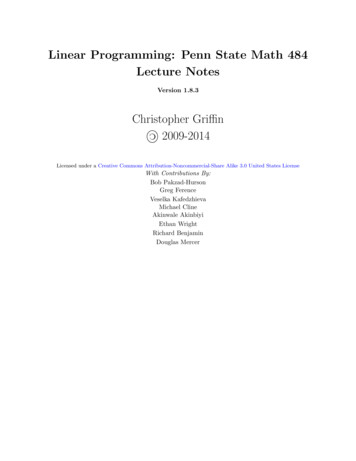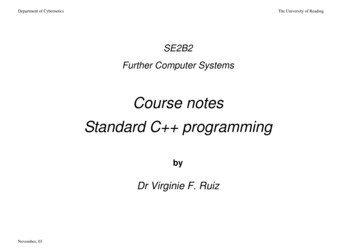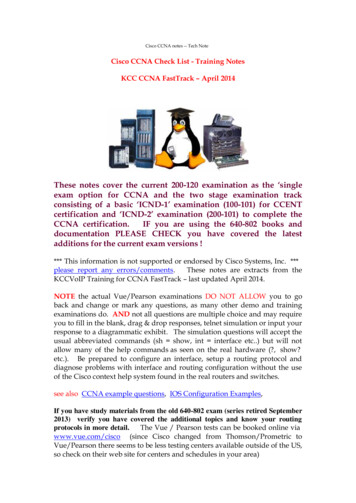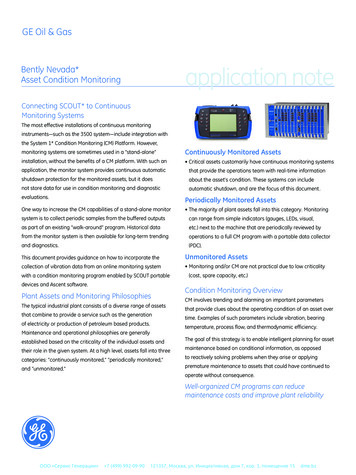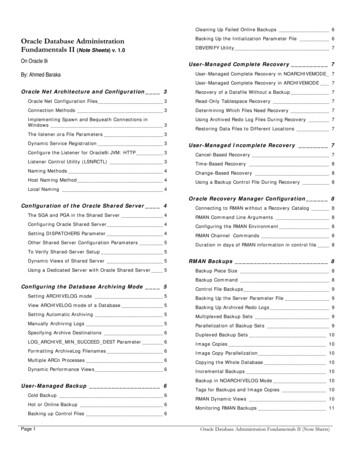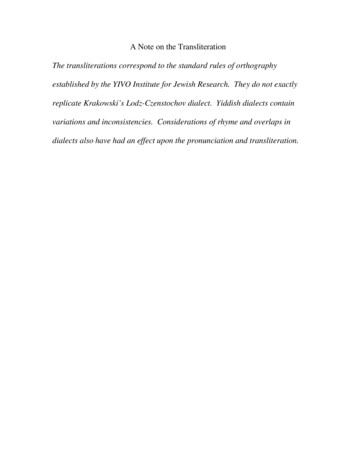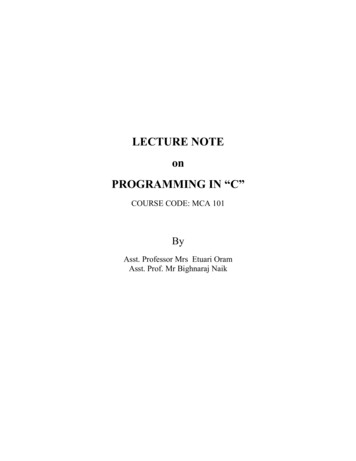
Transcription
LECTURE NOTEonPROGRAMMING IN “C”COURSE CODE: MCA 101ByAsst. Professor Mrs Etuari OramAsst. Prof. Mr Bighnaraj Naik
SYLLABUSModule –IC Language Fundamentals.Character set, Identifiers, keyword, data types, Constants and variables, statements,expression, operators, precedence of operators, Input-output, Assignments, control structuresdecision making and branching.Module -IIArrays, Functions and Strings: Declaration, manipulation and String – handlingfunctions, monolithic vs. Modular programs, user defined vs. standard functions, formal vs. actualarguments, function – category, function prototypes, parameter passing, recursion, and storage classes:auto, extern, global, static.Module –IIIPointers, Structures, Unions, File handling:Pointer variable and its importance, pointer arithmetic, passing parameters, Declaration of structures,pointer to pointer, pointer to structure, pointer to function, union, dynamic memory allocation, filemanagements.2*Underrevision
CONTENTSModule: 1Lecture 1: Introduction to CLecture 2: Structure of C, compilation, executionLecture 3:character set, identifiers, keywordsLecture 4: constants, variablesLecture 5: expression, operatorsLecture 6: operators continue Lecture 7: loops: do while, whileLecture 8: for loop, break, continue statementLecture 9: control StatementsLecture 10: nesting of if else , if else ladderLecture 11: arraysLecture 12: 2-diamensional arrayModule: 23*Underrevision
Lecture 13: String library functionsLecture 14: functions, categoriesLecture 15: functions categories cont.Lecture 16: Actual arguments and Formal arguments, call by value call byreferenceLecture 17:local, global, static variableLecture 18: monolithic vs modular programming, Storage classesLecture 19:storage class cont., pointerLecture 20: pointer comparison, increment decrementLecture 21: precedence level of pointer, pointer comparisonLecture 22: pointer to pointer, pointer to structureLecture 23: pointer initialization, accessing elementsModule: 3Lecture 24: size of Structure in, array vs structure, array within structureLecture 25: passing structure to function, Nested StructureLecture 26: UnionLecture 27: nesting of unions, dynamic memory allocationLecture 28: dynamic memory allocation conti Lecture 29: dynamic array, fileLecture 30: file operationLecture 31: file operation on stringLecture 32:Lecture 33:4*Underrevision
Lecture Note: 1Introduction to CC is a programming language developed at AT & T’s Bell Laboratories of USAin 1972. It was designed and written by a man named Dennis Ritchie. In the lateseventies C began to replace the more familiar languages of that time like PL/I,ALGOL, etcANSI C standard emerged in the early 1980s, this book was split into twotitles: The original was still called Programming in C, and the title that coveredANSI C was called Programming in ANSI C. This was done because it tookseveral years for the compiler vendors to release their ANSI C compilers and forthem to become ubiquitous. It was initially designed for programming UNIXoperating system. Now the software tool as well as the C compiler is written in C.Major parts of popular operating systems like Windows, UNIX, Linux is stillwritten in C. This is because even today when it comes to performance (speed ofexecution) nothing beats C. Moreover, if one is to extend the operating system towork with new devices one needs to write device driver programs. Theseprograms are exclusively written in C. C seems so popular is because it is reliable,simple and easy to use. often heard today is – “C has been already supercededby languages like C , C# and Java.Program5*Underrevision
There is a close analogy between learning English language and learning Clanguage. The classical method of learning English is to first learn the alphabetsused in the language, then learn to combine these alphabets to form words, whichin turn are combined to form sentences and sentences are combined to formparagraphs. Learning C is similar and easier. Instead of straight-away learning howto write programs, we must first know what alphabets, numbers and specialsymbols are used in C, then how using them constants, variables and keywords areconstructed, and finally how are these combined to form an instruction. A groupof instructions would be combined later on to form a program. Soa computer program is just a collection of the instructions necessary to solve aspecific problem. The basic operations of a computer system form what is knownas the computer’s instruction set. And the approach or method that is used to solvethe problem is known as an algorithm.So for as programming language concern these are of two types.1) Low level language2) High level languageLow level language:6*Underrevision
Low level languages are machine level and assembly level language. Inmachine level language computer only understand digital numbers i.e. in the formof 0 and 1. So, instruction given to the computer is in the form binary digit, whichis difficult to implement instruction in binary code. This type of program is notportable, difficult to maintain and also error prone. The assembly language is onother hand modified version of machine level language. Where instructions aregiven in English like word as ADD, SUM, MOV etc. It is easy to write andunderstand but not understand by the machine. So the translator used here isassembler to translate into machine level. Although language is bit easier,programmer has to know low level details related to low level language. In theassembly level language the data are stored in the computer register, which variesfor different computer. Hence it is not portable.High level language:These languages are machine independent, means it is portable. The language inthis category is Pascal, Cobol, Fortran etc. High level languages are understood bythe machine. So it need to translate by the translator into machine level. Atranslator is software which is used to translate high level language as well as lowlevel language in to machine level language.Three types of translator are there:CompilerInterpreterAssemblerCompiler and interpreter are used to convert the high level language into machinelevel language. The program written in high level language is known as sourceprogram and the corresponding machine level language program is called as objectprogram. Both compiler and interpreter perform the same task but there working isdifferent. Compiler read the program at-a-time and searches the error and liststhem. If the program is error free then it is converted into object program. Whenprogram size is large then compiler is preferred. Whereas interpreter read only oneline of the source code and convert it to object code. If it check error, statement bystatement and hence of take more time.7*Underrevision
Integrated Development Environments (IDE)The process of editing, compiling, running, and debugging programs is oftenmanaged by a single integrated application known as an Integrated DevelopmentEnvironment, or IDE for short. An IDE is a windows-based program that allows usto easily manage large software programs, edit files in windows, and compile, link,run, and debug programs.On Mac OS X, CodeWarrior and Xcode are two IDEs that are used by manyprogrammers. Under Windows, Microsoft Visual Studio is a good example of apopular IDE. Kylix is a popular IDE for developing applications under Linux.Most IDEs also support program development in several different programminglanguages in addition to C, such as C# and C .8*Underrevision
Lecture Note: 2Structure of C Language program1 ) Comment line2) Preprocessor directive3 ) Global variable declaration4) main function( ){Local variables;Statements;}User defined function}}Comment lineIt indicates the purpose of the program. It is represented as/* .*/Comment line is used for increasing the readability of the program. It is useful inexplaining the program and generally used for documentation. It is enclosed withinthe decimeters. Comment line can be single or multiple line but should not benested. It can be anywhere in the program except inside string constant & characterconstant.Preprocessor Directive:9*Underrevision
#include stdio.h tells the compiler to include information about the standardinput/output library. It is also used in symbolic constant such as #define PI3.14(value). The stdio.h (standard input output header file) contains definition&declaration of system defined function such as printf( ), scanf( ), pow( ) etc.Generally printf() function used to display and scanf() function used to read valueGlobal Declaration:This is the section where variable are declared globally so that it can be access byall the functions used in the program. And it is generally declared outside thefunction :main()It is the user defined function and every function has one main() function fromwhere actually program is started and it is encloses within the pair of curly braces.The main( ) function can be anywhere in the program but in general practice it isplaced in the first position.Syntax :main(){ . . .}The main( ) function return value when it declared by data type asint main( ){return 010*Underrevision
}The main function does not return any value when void (means null/empty) asvoid main(void ) or void main(){printf (“C language”);}Output: C languageThe program execution start with opening braces and end with closing brace.And in between the two braces declaration part as well as executable part ismentioned. And at the end of each line, the semi-colon is given which indicatesstatement termination./*First c program with return statement*/#include stdio.h int main (void){printf ("welcome to c Programming language.\n");return 0;}Output: welcome to c programming language.Steps for Compiling and executing the ProgramsA compiler is a software program that analyzes a program developed in a particularcomputer language and then translates it into a form that is suitable for execution11*Underrevision
on a particular computer system. Figure below shows the steps that are involved inentering, compiling, and executing acomputer program developed in the C programming language and the typical Unixcommands that would be entered from the command line.Step 1: The program that is to be compiled is first typed into a file on thecomputer system. There are various conventions that are used for naming files,typically be any name provided the last two characters are “.c” or file withextension .c. So, the file name prog1.c might be a valid filename for a C program.A text editor is usually used to enter the C program into a file. For example, vi is apopular text editor used on Unix systems. The program that is entered into the fileis known as the source program because it represents the original form of theprogram expressed in the C language.Step 2: After the source program has been entered into a file, then proceed to haveit compiled. The compilation process is initiated by typing a special command onthe system. When this command is entered, the name of the file that contains thesource program must also be specified. For example, under Unix, the command toinitiate program compilation is called cc. If we are using the popular GNU Ccompiler, the command we use is gcc.Typing the linegcc prog1.c or cc prog1.cIn the first step of the compilation process, the compiler examines each programstatement contained in the source program and checks it to ensure that it conformsto the syntax and semantics of the language. If any mistakes are discovered by thecompiler during this phase, they are reported to the user and the compilationprocess ends right there. The errors then have to be corrected in the source program(with the use of an editor), and the compilation process must be restarted. Typicalerrors reported during this phase of compilation might be due to an expression thathas unbalanced parentheses (syntactic error), or due to the use of a variable that isnot “defined” (semantic error).12*Underrevision
Step 3: When all the syntactic and semantic errors have been removed from theprogram, the compiler then proceeds to take each statement of the program andtranslate it into a “lower” form that is equivalent to assembly language programneeded to perform the identical task.Step 4: After the program has been translated the next step in the compilationprocess is to translate the assembly language statements into actual machineinstructions. The assembler takes each assembly language statement and converts itinto a binary format known as object code, which is then written into another fileon the system. This file has the same name as the source file under Unix, with thelast letter an “o” (for object) instead of a “c”.Step 5: After the program has been translated into object code, it is ready to belinked. This process is once again performed automatically whenever the cc or gcccommand is issued under Unix. The purpose of the linking phase is to get theprogram into a final form for execution on the computer.If the program uses other programs that were previouslyprocessed by the compiler, then during this phase the programs are linked together.Programs that are used from the system’s program library are also searched andlinked together with the object program during this phase.The process of compiling and linking a program is often called building.The final linked file, which is in an executable object code format, is stored inanother file on the system, ready to be run or executed. Under Unix, this file iscalled a.out by default. Under Windows, the executable file usually has the samename as the source file, with the c extension replaced by an exe extension.13*Underrevision
Step 6: To subsequently execute the program, the command a.out has the effectof loading the program called a.out into the computer’s memory and initiating itsexecution.When the program is executed, each of the statements of the program issequentially executed in turn. If the program requests any data from the user,known as input, the program temporarily suspends its execution so that the inputcan be entered. Or, the program might simply wait for an event, such as a mousebeing clicked, to occur. Results that are displayed by the program, known asoutput, appear in a window, sometimes called the console. If the program does notproduce the desired results, it is necessary to go back and reanalyze the program’slogic. This is known as the debugging phase, during which an attempt is made toremove all the known problems or bugs from the program. To do this, it will most14*Underrevision
likely be necessary to make changes to original source program.15*Underrevision
/* Simple program to add two numbers .*/16*Underrevision
#include stdio.h int main (void){int v1, v2, sum;//v1,v2,sum are variables and int is data type declaredv1 150;v2 25;sum v1 v2;printf ("The sum of %i and %i is %i\n", v1, v2, sum);return 0;}Output:The sum of 150 and 25 is 175Lecture Note: 3Character setA character denotes any alphabet, digit or special symbol used to representinformation. Valid alphabets, numbers and special symbols allowed in C are17*Underrevision
The alphabets, numbers and special symbols when properly combined formconstants, variables and keywords.IdentifiersIdentifiers are user defined word used to name of entities like variables, arrays,functions, structures etc. Rules for naming identifiers are:1) name should only consists of alphabets (both upper and lower case), digitsand underscore ( ) sign.2) first characters should be alphabet or underscore3) name should not be a keyword4) since C is a case sensitive, the upper case and lower case considereddifferently, for example code, Code, CODE etc. are different identifiers.5) identifiers are generally given in some meaningful name such as value,net salary, age, data etc. An identifier name may be long, some implementationrecognizes only first eight characters, most recognize 31 characters. ANSIstandard compiler recognize 31 characters. Some invalid identifiers are 5cb, int,res#, avg no etc.Keyword18*Underrevision
There are certain words reserved for doing specific task, these wordsare known as reserved word or keywords. These words are predefined and alwayswritten in lower case or small letter. These keywords cann’t be used as a variablename as it assigned with fixed meaning. Some examples are int, short, signed,unsigned, default, volatile, float, long, double, break, continue, typedef, static,do, for, union, return, while, do, extern, register, enum, case, goto, struct,char, auto, const etc.data typesData types refer to an extensive system used for declaring variables or functions ofdifferent types before its use. The type of a variable determines how much space itoccupies in storage and how the bit pattern stored is interpreted. The value of avariable can be changed any time.C has the following 4 types of data typesbasic built-in data types: int, float, double, charEnumeration data type: enumDerived data type: pointer, array, structure, unionVoid data type: voidA variable declared to be of type int can be used to contain integral valuesonly—that is, values that do not contain decimal places. A variable declared to beof type float can be used for storing floating- point numbers (values containingdecimal places). The double type is the same as type float, only with roughly twicethe precision. The char data type can be used to store a single character, such as theletter a, the digit character 6, or a semicolon similarly A variable declared char canonly store character type value.There are two types of type qualifier in cSize qualifier: short, longSign qualifier: signed, unsigned19*Underrevision
When the qualifier unsigned is used the number is always positive, and whensigned is used number may be positive or negative. If the sign qualifier is notmentioned, then by default sign qualifier is assumed. The range of values forsigned data types is less than that of unsigned data type. Because in signed type,the left most bit is used to represent sign, while in unsigned type this bit is alsoused to represent the value. The size and range of the different data types on a 16bit machine is given below:Basic data type Data type with typequalifiercharchar or signed charUnsigned charintint or signed intunsigned intshort int or signed short intunsigned short intlong int or signed long intunsigned long intfloatfloatdoubledoubleLong double20Size(byte)112211444810Range-128 to 1270 to 255-32768 to 327670 to 65535-128 to 1270 to 255-2147483648 to 21474836470 to 4294967295-3.4E-38 to 3.4E 381.7E-308 to 1.7E 3083.4E-4932 to 1.1E 4932*Underrevision
Lecture Note: 4ConstantsConstant is a any value that cannot be changed during program execution. In C,any number, single character, or character string is known as a constant. A constantis an entity that doesn’t change whereas a variable is an entity that may change.For example, the number 50 represents a constant integer value. The characterstring "Programming in C is fun.\n" is an example of a constant character string. Cconstants can be divided into two major categories:Primary ConstantsSecondary ConstantsThese constants are further categorized asNumeric constantCharacter constantString constant21*Underrevision
Numeric constant: Numeric constant consists of digits. It required minimum sizeof 2 bytes and max 4 bytes. It may be positive or negative but by default sign isalways positive. No comma or space is allowed within the numeric constant and itmust have at least 1 digit. The allowable range for integer constants is -32768 to32767. Truly speaking the range of an Integer constant depends upon the compiler.For a 16-bit compiler like Turbo C or Turbo C the range is –32768 to 32767.For a 32-bit compiler the range would be even greater. Mean by a 16-bit or a 32bit compiler, what range of an Integer constant has to do with the type of compiler.It is categorized a integer constant and real constant. An integer constants arewhole number which have no decimal point. Types of integer constants are:Decimal constant:0-------9(base 10)Octal constant:0-------7(base 8)Hexa decimal constant: 0----9, A------F(base 16)In decimal constant first digit should not be zero unlike octal constant first digitmust be zero(as 076, 0127) and in hexadecimal constant first two digit should be0x/ 0X (such as 0x24, 0x87A). By default type of integer constant is integer but ifthe value of integer constant is exceeds range then value represented by integertype is taken to be unsigned integer or long integer. It can also be explicitlymention integer and unsigned integer type by suffix l/L and u/U.Real constant is also called floating point constant. To construct real constant wemust follow the rule of ,-real constant must have at least one digit.-It must have a decimal point.-It could be either positive or negative.-Default sign is positive.-No commas or blanks are allowed within a real constant. Ex.: 325.34426.0-32.76To express small/large real constant exponent(scientific) form is used wherenumber is written in mantissa and exponent form separated by e/E. Exponent canbe positive or negative integer but mantissa can be real/integer type, for example3.6*105 3.6e 5. By default type of floating point constant is double, it can also beexplicitly defined it by suffix of f/F.Character constant22*Underrevision
Character constant represented as a single character enclosed within a singlequote. These can be single digit, single special symbol or white spaces such as‘9’,’c’,’ ’, ‘ ’ etc. Every character constant has a unique integer like value inmachine’s character code as if machine using ASCII (American standard code forinformation interchange). Some numeric value associated with each upper andlower case alphabets and decimal integers are as:A------------ Z ASCII value (65-90)a-------------z ASCII value (97-122)0-------------9 ASCII value (48-59);ASCII value (59)String constantSet of characters are called string and when sequence of characters areenclosed within a double quote (it may be combination of all kind of symbols) is astring constant. String constant has zero, one or more than one character and at theend of the string null character(\0) is automatically placed by compiler. Someexamples are “,sarathina” , “908”, “3”,” ”, “A” etc. In C although same charactersare enclosed within single and double quotes it represents different meaning suchas “A” and ‘A’ are different because first one is string attached with null characterat the end but second one is character constant with its corresponding ASCII valueis 65.Symbolic constantSymbolic constant is a name that substitute for a sequence of characters and,characters may be numeric, character or string constant. These constant aregenerally defined at the beginning of the program as#define name value , here name generally written inupper case for example23*Underrevision
#define MAX 10#define CH ‘b’#define NAME “sony”VariablesVariable is a data name which is used to store some data value or symbolic namesfor storing programcomputations and results. The value of the variable can be change during theexecution. The rule for naming the variables is same as the naming identifier.Before used in the program it must be declared. Declaration of variables specify itsname, data types and range of the value that variables can store depends upon itsdata types.Syntax:int a;char c;float f;Variable initializationWhen we assign any initial value to variable during the declaration, is calledinitialization of variables. When variable is declared but contain undefined valuethen it is called garbage value. The variable is initialized with the assignmentoperator such asData type variable name constant;Example: int a 20;Or int a;a 20;24*Underrevision
statementsLecture Note: 5ExpressionsAn expression is a combination of variables, constants, operators and function call.It can be arithmetic, logical and relational for example:int z x ya b// arithmatic expression//relationala b// logicalfunc(a, b) // function callExpressions consisting entirely of constant values are called constant expressions.So, the expression121 17 - 110is a constant expression because each of the terms of the expression is a constantvalue. But if i were declared to be an integer variable, the expression180 2 – jwould not represent a constant expression.OperatorThis is a symbol use to perform some operation on variables, operands or with theconstant. Some operator required 2 operand to perform operation or Somerequired single operation.Several operators are there those are, arithmetic operator, assignment, increment ,decrement, logical, conditional, comma, size of , bitwise and others.1. Arithmatic OperatorThis operator used for numeric calculation. These are of either Unary arithmeticoperator, Binary arithmetic operator. Where Unary arithmetic operator required25*Underrevision
only one operand such as ,-, , --,!, tiled. And these operators are addition,subtraction, multiplication, division. Binary arithmetic operator on other handrequired two operand and its operators are (addition), -(subtraction),*(multiplication), /(division), %(modulus). But modulus cannot applied withfloating point operand as well as there are no exponent operator in c.Unary ( ) and Unary (-) is different from addition and subtraction.When both the operand are integer then it is called integer arithmetic and the resultis always integer. When both the operand are floating point then it is called floatingarithmetic and when operand is of integer and floating point then it is called mixtype or mixed mode arithmetic . And the result is in float type.2.Assignment OperatorA value can be stored in a variable with the use of assignment operator. Theassignment operator( ) is used in assignment statement and assignment expression.Operand on the left hand side should be variable and the operand on the right handside should be variable or constant or any expression. When variable on the lefthand side is occur on the right hand side then we can avoid by writing thecompound statement. For example,int x y;int Sum x y z;3.Increment and DecrementThe Unary operator , --, is used as increment and decrement which acts uponsingle operand. Increment operator increases the value of variable by one.Similarly decrement operator decrease the value of the variable by one. And theseoperator can only used with the variable, but cann't use with expression andconstant as 6 or (x y z).26*Underrevision
It again categories into prefix post fix . In the prefix the value of the variable isincremented 1st, then the new value is used, where as in postfix the operator iswritten after the operand(such as m ,m--).EXAMPLElet y 12;z y;y y 1;z y;Similarly in the postfix increment and decrement operator is used in the operation .And then increment and decrement is perform.EXAMPLElet x 5;y x ;y x;x x 1;4.Relational OperatorIt is use to compared value of two expressions depending on their relation.Expression that contain relational operator is called relational expression.Here the value is assign according to true or false value.a.(a b) (b 20)b.(b a) && (e b)c. 0(b! 7)5. Conditional Operator27*Underrevision
It sometimes called as ternary operator. Since it required three expressions asoperand and it is represented as (? , :).SYNTAXexp1 ? exp2 :exp3Here exp1 is first evaluated. It is true then value return will be exp2 . If false thenexp3.EXAMPLEvoid main(){int a 10, b 2int s (a b) ? a:b;printf(“value is:%d”);}Output:Value is:106. Comma OperatorComma operator is use to permit different expression to be appear in a situationwhere only one expression would be used. All the expression are separator bycomma and are evaluated from left to right.EXAMPLEint i, j, k, l;for(i 1,j 2;i 5;j 10;i ;j )28*Underrevision
7. Sizeof OperatorSize of operator is a Unary operator, which gives size of operand in terms of bytethat occupied in the memory. An operand may be variable, constant or data typequalifier.Generally it is used make portable program(program that can be run on differentmachine) . It determines the length of entities, arrays and structures when their sizeare not known to the programmer. It is also use to allocate size of memorydynamically during execution of the program.EXAMPLEmain( ){int sum;float f;printf( "%d%d" ,size of(f), size of (sum) );printf("%d%d", size of(235 L), size of(A));}29*Underrevision
Lecture Note: 68. Bitwise OperatorBitwise operator permit programmer to access and manipulate of data at bit level.Various bitwise operator enlisted areone's complement( )bitwise AND(&)bitwise OR( )bitwise XOR( )left shift( )right shift( )These operator can operate on integer and character value but not on float anddouble. In bitwise operator the function showbits( ) function is used to display thebinary representation of any integer or character value.In one's complement all 0 changes to 1 and all 1 changes to 0. In the bitwise OR itsvalue would obtaining by 0 to 2 bits.As the bitwise OR operator is used to set on a particular bit in a number. BitwiseAND the logical AND.It operate on 2operands and operands are compared on bit by bit basic. And henceboth the operands are of same type.Logical or Boolean OperatorOperator used with one or more operand and return either value zero (for false) orone (for true). The operand may be constant, variables or expressions. And theexpression that combines two or more expressions is termed as logical expression.C has three logical operators :30*Underrevision
OperatorMeaning&&AND OR!NOTWhere logical NOT is a unary operator and other two are binary operator. LogicalAND gives result true if both the conditions are true, otherwise result is false. Andlogial OR gives result false if both the condition false, otherwise result is tr
Introduction to C C is a programming language developed at AT & T’s Bell Laboratories of USA in 1972. It was designed and written by a man named Dennis Ritchie. In the late seventies C began to replace the more familiar languages of that time like PL/I, ALGOL, etcFile Size: 396KB





